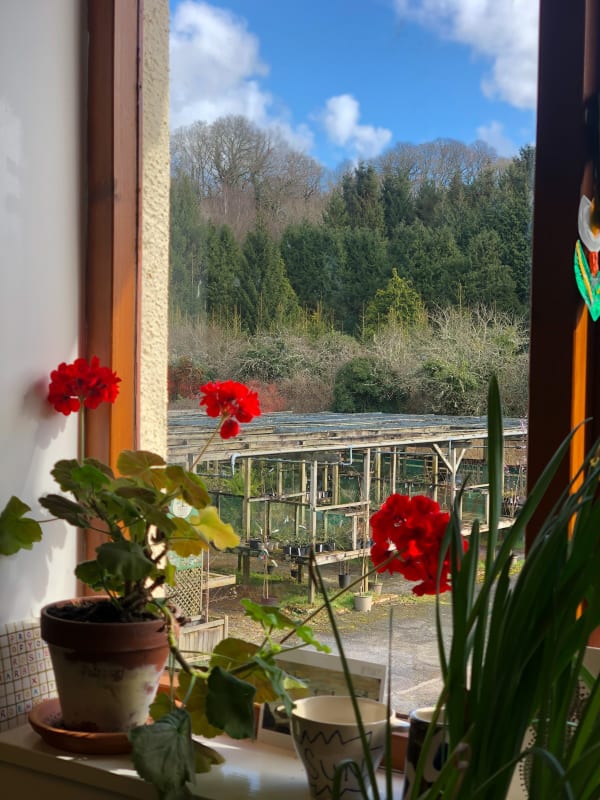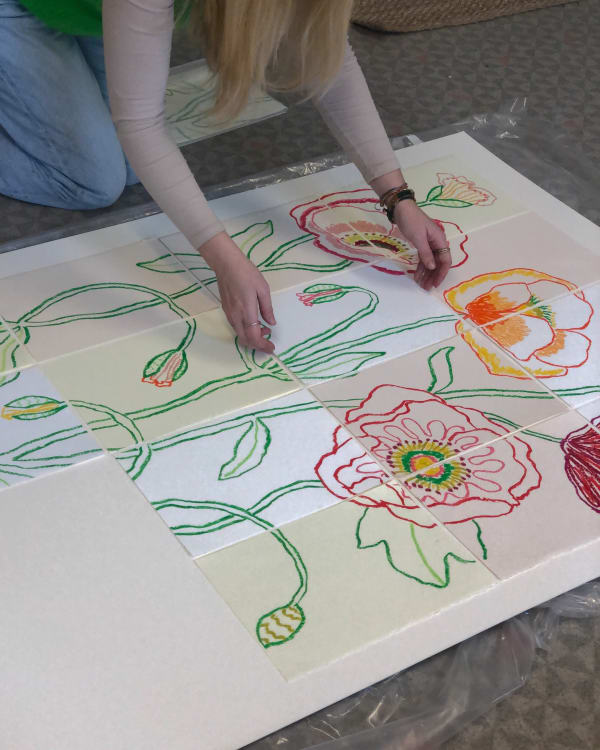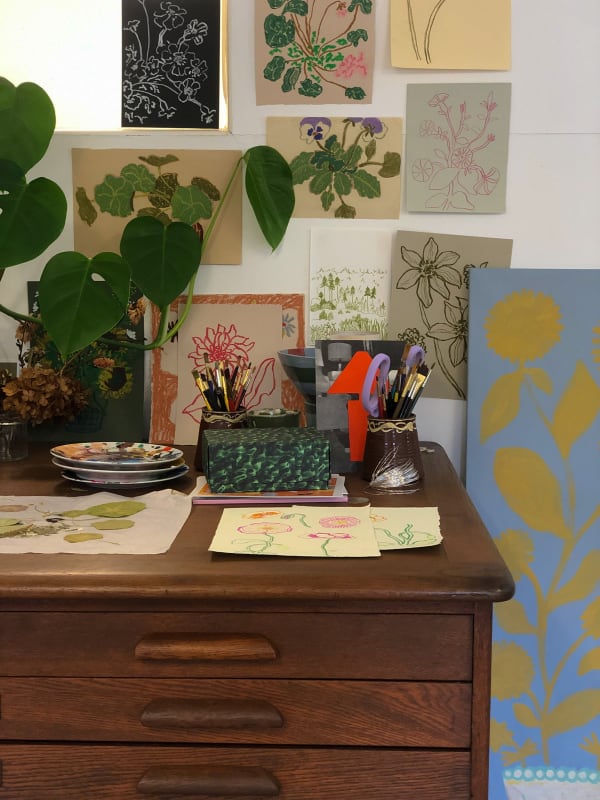Music is very important to my creative process, a piece of music or song can often determine the direction of a painting, as I create from feeling as well as a vision.
– Rosie Harbottle, 2024
EASTWOOD FINE ART: Your work is closely informed by nature, and defined by a distinct use of line, form and luminous colour that is both bold and sparing. Are there specific makers or sources you look to for inspiration, such as gardens, artists, musicians or books?
ROSIE HARBOTTLE: We live in a little wooden house on the edge of Dartmoor surrounded by trees with a small river that runs through the garden, and so very much live amongst nature. Inspiration is all around and I love being guided by the seasons in terms of the plants and flowers that I draw and paint. Music is also very important to my creative process, a piece of music or song can often determine the direction of a painting, as I create from feeling as well as a vision. In the studio, you will mainly find me listening to folk music or Afrobeat. I adore colour and particularly love the work of Milton Avery, Vanessa Bell, and Pierre Boncompain amongst others, and their work will often inspire an idea or colour combination that I haven't yet explored.
EFA: Colour is an essential element in both your drawings and paintings, and is often not bound to real life, how do you see colour in your work?
RH: I think the main thing I'm trying to capture in my work is the personality of the natural world, through colour. I try to evoke a mood and the feeling I get when I'm surrounded by nature rather than using 'accurate' colours. My work is a celebration of colour and the natural world. I always approach pieces with the palette in mind before I start. I do very quick pencil sketches first to realise the composition and then armed with colour references I work quickly to get the idea onto canvas. Most of the time I can 'see' the finished painting in my mind before I start, and colour massively informs this. Of course, in the process, I may tweak the design but generally not the palette. With the large drawings I have to be more precise. I make a number of coloured pencil drawings first to work out the composition and colours I'll use. The large drawings have to be created very confidently as there is a balance between the freedom of mark making and the precision in where each flower, stem, and leaf are drawn. Mistakes aren't an option with these as there is no way to erase any accidental marks.
EFA: Before committing to your own work as an artist, you had a career as a commercial illustrator for many years. Has your experience impacted how you approach your work?
RH: My experience as an illustrator working across textile design, surface pattern, and stationery has informed and impacted my work a great deal. I was always working towards briefs and mood boards, and still work best when there is direction – so I will set my own parameters for collections to help keep me focused. Pattern has always been a big part of my work too and so I'm very inspired by textiles and love incorporating pattern and detail into my paintings.
EFA: In January, you presented a solo exhibition at The Garden Museum in London, could tell us more about this project and what’s next?
RH: I had a wonderful opportunity to work with British lifestyle brand TOAST, who asked me to create three artworks that were to be reproduced and hung in all of their store windows across the country to celebrate the new S/S24 collection, 'Outdoor Pursuits'. Part of this collaboration was an exhibition at the Garden Museum which was such a lovely project to be a part of. I showed around 20 pieces which were all inspired by the theme and how my life in the countryside is inspired by the outdoors and feeds into this.
EFA: For SPOTLIGHT, you are showing two new works on paper – titled Icelandic Poppies and Tulips I, both 2024 – could you tell us more about them?
RH: These two works are drawings of a couple of classic spring blooms. When I'm planning these large drawings I always like to depict flowers that have a lot of personality or pattern. Poppies with their twisty stems and bold colour and tulips with their endless array of patterning. I experimented with more panels for 'Poppies' to create a patchwork or tile-like effect as I wanted to emphasise the sculptural quality of these pieces.







